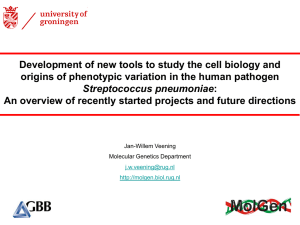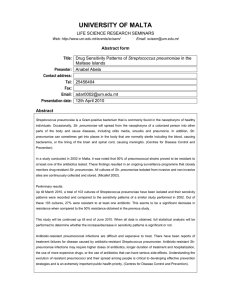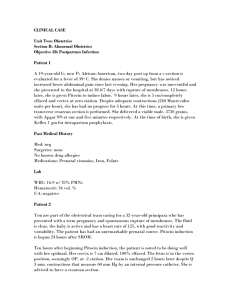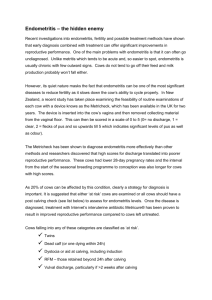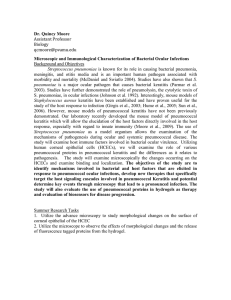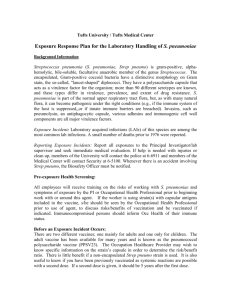Case Report
advertisement
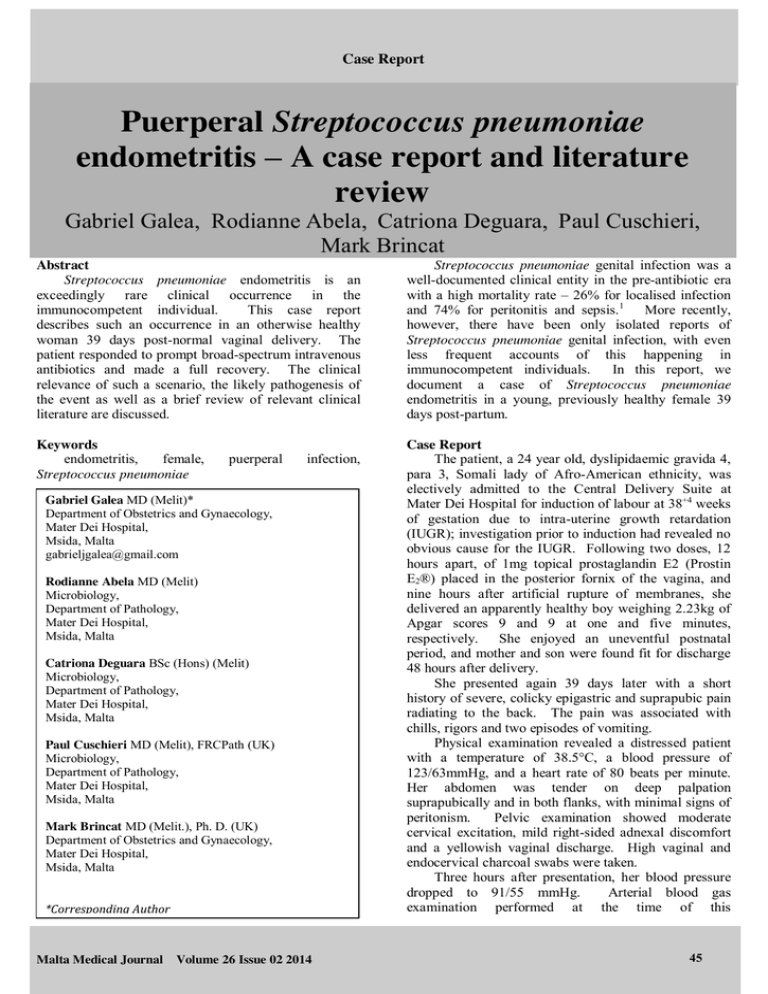
Case Report Puerperal Streptococcus pneumoniae endometritis – A case report and literature review Gabriel Galea, Rodianne Abela, Catriona Deguara, Paul Cuschieri, Mark Brincat Abstract Streptococcus pneumoniae endometritis is an exceedingly rare clinical occurrence in the immunocompetent individual. This case report describes such an occurrence in an otherwise healthy woman 39 days post-normal vaginal delivery. The patient responded to prompt broad-spectrum intravenous antibiotics and made a full recovery. The clinical relevance of such a scenario, the likely pathogenesis of the event as well as a brief review of relevant clinical literature are discussed. Streptococcus pneumoniae genital infection was a well-documented clinical entity in the pre-antibiotic era with a high mortality rate – 26% for localised infection and 74% for peritonitis and sepsis. 1 More recently, however, there have been only isolated reports of Streptococcus pneumoniae genital infection, with even less frequent accounts of this happening in immunocompetent individuals. In this report, we document a case of Streptococcus pneumoniae endometritis in a young, previously healthy female 39 days post-partum. Keywords endometritis, female, Streptococcus pneumoniae Case Report The patient, a 24 year old, dyslipidaemic gravida 4, para 3, Somali lady of Afro-American ethnicity, was electively admitted to the Central Delivery Suite at Mater Dei Hospital for induction of labour at 38+4 weeks of gestation due to intra-uterine growth retardation (IUGR); investigation prior to induction had revealed no obvious cause for the IUGR. Following two doses, 12 hours apart, of 1mg topical prostaglandin E2 (Prostin E2®) placed in the posterior fornix of the vagina, and nine hours after artificial rupture of membranes, she delivered an apparently healthy boy weighing 2.23kg of Apgar scores 9 and 9 at one and five minutes, respectively. She enjoyed an uneventful postnatal period, and mother and son were found fit for discharge 48 hours after delivery. She presented again 39 days later with a short history of severe, colicky epigastric and suprapubic pain radiating to the back. The pain was associated with chills, rigors and two episodes of vomiting. Physical examination revealed a distressed patient with a temperature of 38.5°C, a blood pressure of 123/63mmHg, and a heart rate of 80 beats per minute. Her abdomen was tender on deep palpation suprapubically and in both flanks, with minimal signs of peritonism. Pelvic examination showed moderate cervical excitation, mild right-sided adnexal discomfort and a yellowish vaginal discharge. High vaginal and endocervical charcoal swabs were taken. Three hours after presentation, her blood pressure dropped to 91/55 mmHg. Arterial blood gas examination performed at the time of this puerperal infection, Gabriel Galea MD (Melit)* Department of Obstetrics and Gynaecology, Mater Dei Hospital, Msida, Malta gabrieljgalea@gmail.com Rodianne Abela MD (Melit) Microbiology, Department of Pathology, Mater Dei Hospital, Msida, Malta Catriona Deguara BSc (Hons) (Melit) Microbiology, Department of Pathology, Mater Dei Hospital, Msida, Malta Paul Cuschieri MD (Melit), FRCPath (UK) Microbiology, Department of Pathology, Mater Dei Hospital, Msida, Malta Mark Brincat MD (Melit.), Ph. D. (UK) Department of Obstetrics and Gynaecology, Mater Dei Hospital, Msida, Malta *Corresponding Author Malta Medical Journal Volume 26 Issue 02 2014 45 Case Report haemodynamic deterioration revealed a pH of 7.39, pO2 of 86.5 mmHg, pCO2 of 36.0 and a lactate level of 2.8. Peripheral blood studies revealed a leucocytosis with neutrophil shift; inflammatory markers – erythrocyte sedimentation rate (ESR) and C-reactive protein (CRP) – were found to be raised. Amylase was normal and urine and peripheral blood cultures were eventually returned negative. The patient was initially admitted to a surgical bed; intra-venous piperacillin-tazobactam (Tazocin®) was commenced. Computed tomography scanning of her abdomen revealed an enlarged uterus with oedematous changes in the uterine wall and free fluid in the pouch of Douglas. She was transferred to a gynaecological bed. Treatment remained unchanged. Symptomatic improvement and gradual normalisation of ESR and CRP were seen and piperacillin-tazobactam was changed to oral coamoxiclav (Augmentin®). A pure culture of mucoid, Gram-positive diplococci with lanceolate morphology was obtained from the patient’s endocervical swab. The presence of Streptococcus pneumoniae was confirmed by showing draughtsman colonies with weak α-haemolysis on horse blood agar, sensitivity to ethyl hydrocuprein (optochin), and bile solubility. The presence of a polysaccharide capsule was confirmed by using the Phadebact® Pneumococcus Co-agglutination test. The isolate was sensitive to penicillins, macrolides and newer generation fluoroquinolones. A final diagnosis of puerperal S. pneumoniae endometritis was made. 2-3 After five days of oral antibiotic treatment, the patient was discharged home on a further 3 days of antibiotics. She remained well at an outpatient appointment followup 4 weeks later. Discussion In the pre-antibiotic era, S. pneumoniae not infrequently caused female genital tract infections as a consequence of septic abortion, instrumental vaginal delivery and metastatic seeding of pneumococcal septicaemia.4 However, primary pneumococcal infection of the female genital tract, as documented in this case scenario is, nowadays, an extremely rare occurrence. Pneumococci are not components of normal vaginal 5-6 flora : in a literature review in 1990, Westh et al. described three studies where pneumococci were only cultured from 9 genital isolates out of a total of 1715 patients (0.5%)1 while a further three microbiological studies gave no mention whatsoever of pneumococcus isolates from the female genital tract.7-9 It is thought that pneumococci are unable to survive at normal vaginal pH; although it is postulated that changes in vaginal pH, as for example during pregnancy and the puerperium, may temporarily allow S. pneumoniae to exist as a Malta Medical Journal Volume 26 Issue 02 2014 vaginal commensal.5-6 Risk factors for pneumococcal infection include antibody and complement deficiency, asplenia, neutropenia or impaired neutrophil function, steroid therapy, malnutrition, alcoholism, chronic medical conditions (renal failure, liver failure, heart failure, and respiratory pathology) and overcrowding.10-12 The organism possesses a number of virulence factors that aid in the pathogenesis of infection10-12: 1. Polysaccharide capsule – prevents opsonisation and phagocytosis. Different serotypes exhibit different severity of infection. 2. IgA protease – cleaves IgA1 and enables evasion of the protective function of this immunoglobulin isotype. 3. Pneumolysin – an intracellular membranedamaging toxin released by autolysis. It serves to inhibit neutrophil chemotaxis, phagocytosis and respiratory burst, lymphocyte proliferation and immunoglobulin synthesis. 4. Autolysin - breaks the peptide cross-linking of the cell wall resulting in cell lysis and release of pneumolysin as well as cell wall fragments. Most reports on pneumococcal female genital tract infections with or without secondary pneumococcal peritonitis suggest three possible mechanisms by which pneumococci can infect the genital tract or peritoneum.1 These include: Infection via the external genitalia – following a change in vaginal pH, it is thought that S. pneumoniae can exist as a commensal. Pneumococcal Bartholinitis has been described as have ascending infections. The presence of an intra-uterine device, instrumentation of the uterine cavity, the use of tampons13 and the puerperal period are all thought to facilitate ascending infection from the vagina.1 Infections via the bloodstream – this is exceedingly uncommon nowadays and is associated with a high mortality (presumably secondary to metastatic pneumococcal infection and septicaemia and not specifically to genital tract involvement) Infection following orogenital sex – pneumococci are known commensals of the oropharynx and it has been postulated that orogenital sex can cause pneumococcal and Haemophilus influenzae genital tract colonization and possibly infection.13 Paradoxically, Pitroff et al. in 2012 suggested that oral sex might actually be protective and decrease the risk of endometritis.14 Infection via the gastrointestinal tract and via transdiaphragmatic lymphatics have also been suggested as mechanisms of infections 10 but a literature search yielded no evidence confirming these theories. Fernandez et al., in a 1993 prospective study on 1291 patients, suggested that a single 1.2g intra-venous 46 Case Report dose of co-amoxiclav at the onset of labour would decrease the risk of postpartum endometritis and also be cost effective.15 While a comprehensive 2007 article on puerperal pyrexia by Maharaj suggests that high risk patients (those with previous spontaneous preterm delivery, history of low birth weight, pre-pregnancy weight less than 50 kg, or bacterial vaginosis in the current pregnancy) might benefit from prophylactic antibiotics in the second and third trimester of pregnancy, the author stops short of recommending the routine use of prophylactic antibiotics against postpartum endometritis.16 A 2007 Cochrane review of antibiotic choices for the treatment of established post-partum endometritis recommends the use of intravenous clindamycin and a once-daily dose of gentamicin, with no benefit seen with further oral antibiotics once clinical improvement is sustained for more than 24 hours17; this recommended combination was not used in this scenario due to a delay in diagnosis. The rationale behind these recommendations is based on the sensitivities of the commoner causative organisms of puerperal endometritis. Although S. pneumoniae endometritis is a highly uncommon aetiological agent for post-partum endometritis, no change to usual clinical practice is needed in view of the fact that an intravenous clindamycin-gentamicin combination would appropriately treat this rare scenario. 12. 13. 14. 15. 16. 17. Ed. Philadelphia: Churchill Livingstone Elsevier; 2009. Cohen J, Powderly WG, Opal SM. Infectious Diseases. 3rd Ed. Philadelphia: Mosby Elsevier; 2010. Ostrowska KI, Rotstein C, Thornley JH, Mandell L. Pneumococcal endometritis with peritonitis: Case report and review of the literature. Can J Infect Dis. 1991;Winter 2(4):161-4. Pitroff R, Sully E, Bass DC, Kelsey SF, Ness RB, Haggerty CL. Stimulating an immune response? Oral sex is associated with less endometritis. Int J STD AIDS. 2012;23(11):775-80. Fernandez H, Gagnepain A, Bourget P, Peray P, Frydman R, Papiernik E, et al. Antibiotic prophylaxis against postpartum endometritis after vaginal delivery: a prospective randomized comparison between Amox-CA (Augmentin®) and abstention. Eur J Obstet Gynecol Reprod Biol. 1993;50(3):169-75 . Maharaj D. Puerperal pyrexia: a review. Part II. Obstet Gynecol Surv. 2007;62(6):400-6. French LM, Smaill FM. Antibiotic regimens for endometritis after delivery (Review). The Cochrane Library, Issue 4, 2007. Chichester: Wiley. References 1. 2. 3. 4. 5. 6. 7. 8. 9. 10. 11. Westh H, Skibsted L, Korner B. Streptococcus pneumoniae infections of the female genital tract and in the newborn child. Rev. Infect Dis. 1990;12:416-22. Lindeque BG. Abnormalities of the puerperium. In: Cronje HS, Grobler CJ, editors. Obstetrics in Southern Africa. 2nd ed. Pretoria: Van Schaik Publishers; 200:380-90. Royal College of Obstetricians and Gynaecologists. Bacterial Sepsis following Pregnancy. Green-top Guideline No. 64b. London: RCOG; 2012:2 p. 4 Patterson D, Johnson CM, Monif GR. Streptococcus pneumoniae as a cause of Salpingitis. Infect Dis Obstet Gynecol. 1994;1:290-2. McCarthy VP, Cho CT. Endometritis and Neonatal Sepsis Due to Streptococcus pneumonia. Obstet Gynecol. 1979;53 Suppl 3:S47-9. Nuchols HH, Hertig AT. Pneumococcus infection of the genital tract in women: Especially during pregnancy and the puerperium. Am J Obstet Gynecol. 1938;35:782-93. Ohm MJ, Galask RP. Bacterial flora of the cervix from 100 prehysterectomy patients. Am J Obstet Gynecol. 1975;122:6837. Ledger WJ, Norman M, Gee C, Lewis W. Bacteremia on an obstetric-gynecologic service. Am J Obstet Gynecol. 1975;121:205-12. Gibbs RS, O’Dell RN, MacGregor RR, Schwarz RH, Morton H. Puerperal endometritis: A prospective microbiologic study. Am J Obstet Gynecol. 1975;121:919-25. Török E, Moran E, Cooke F. Oxford Handbook of Infectious Diseases and Microbiology. 1st Ed. Oxford: Oxford University Press; 2009. Mandell GL, Bennet JE, Dolin R. Mandell, Douglas, and Bennett’s principles and practice of Infectious Diseases. 7th Malta Medical Journal Volume 26 Issue 02 2014 47
